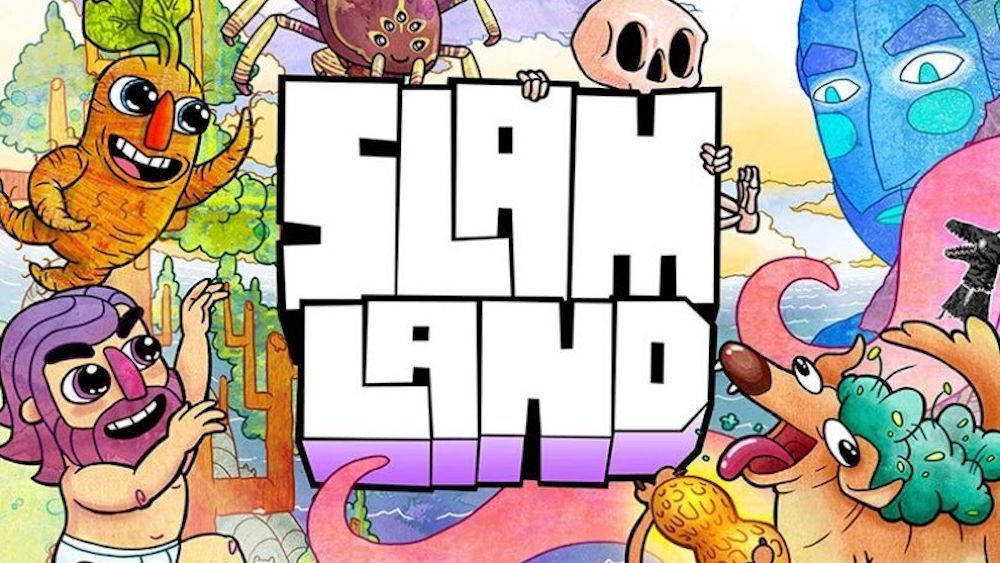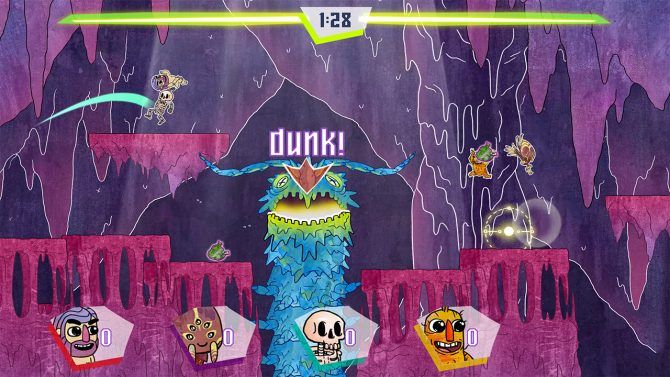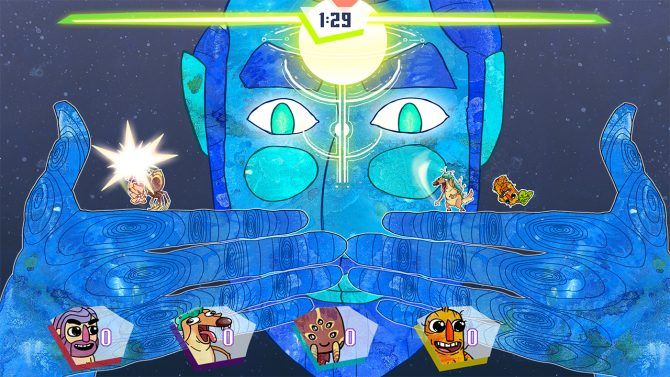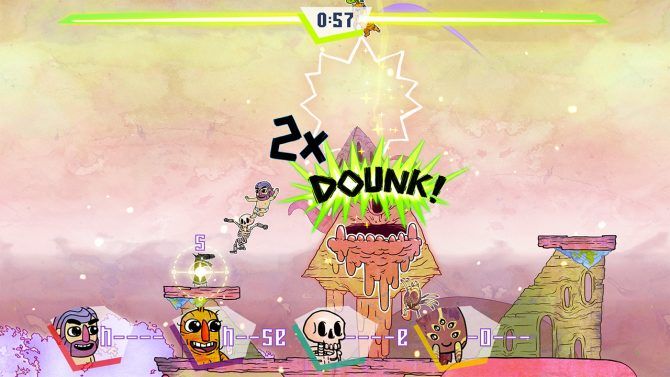Each video game establishes its own degree of literacy—that is, every new game that one plays has to teach them the ways of its language. This will generally come in some form of tutorial, whether they be optional or a part of whatever story the game is telling. Simply put, games go out of their way to make sense for the player. Slam Land is a video game that eschews all of that.
Besides a brief tutorial that shows players how to move, jump, and "slam," this four-player party game makes no effort to teach players its own mechanics, and could not be any vaguer in describing its own set of features. It is a disorienting experience. The fascinating thing about Slam Land, however, is that its disorientation appears to be by design.
[pullquote]"The fascinating thing about Slam Land, however, is that its disorientation appears to be by design."[/pullquote]
Assigning just one genre to Slam Land would be disingenuous—it is a motley mix of several genres, including party, sports, and platform fighter, a la Super Smash Bros. The basic mechanic of the game is "slamming," which involves players picking up either other players or objects and dunking them into a designated spot. The action, which can include up to four players, takes place on large, 2D stages.
The premise of the game is just as nebulous as everything else surrounding it. While other games have silent and otherwise mysterious narratives, they leave pieces behind in the environment for the player to cobble up some ideas about the world. Slam Land has very few pieces to work with, but the game revolves around a group of grotesque-looking characters attempting to impress some sort of giant, blue head deity, with "mighty and majestic slams" being the primary method of doing so.
The art style is psychedelic and surreal, reminiscent of absurdist animated shows on networks like Adult Swim. There are no named characters in the game, but there are variations of these playable avatars, which include humans, dogs, skeletons, carrots, and spiders, all of which play the same. With or without any lore to this game, watching these characters in motion looks like a straight-up acid trip, enhanced with nonsense words, phrases, and onomatopoeias such as "DOUNK!" and "BLAM JAM!" There's a discomforting nature to the look of the game—but admittedly, it makes it funny and entertaining in its own weird way. Slam Land is truly bizarre, but its unpredictability adds a unique charm that gives it its own identity. While I wish that there were elements like animated cutscenes or voice acting to texture the world of the game more, I couldn't help but laugh and smile at much of the on-screen absurdity.
[pullquote]"Slam Land is truly bizarre, but its unpredictability adds a unique charm that gives it its own identity."[/pullquote]
Slam Land offers five game modes, none accompanied by any instructions, but all self-explanatory by the name itself. Quick Slam is the core game type, where players attempt to pick each other up and dunk them into the "hoop," which could be a literal hoop, a tree trunk, or something crazy like a giant blue worm. Peanut has players fight over a giant peanut—the longer one holds the peanut, the more points it stacks up, and dunking the peanut into the hoop will score that player the points that it holds. Horse will have several disturbing-looking horse statues, each representing a different letter of the word; rounds end when a player spells out the entirety of "HORSE." Trash will have players pick up and stack several trash bags to dunk. Finally, Slam Tour shuffles through all of the game above types round after round. These rounds are timed, with the option of stock matches.
Where the game falters is, well, with the actual gameplay itself. Calling the gameplay Smash Bros.-esque is probably giving Slam Land too much credit, as it makes the false implication of several movement and control options that can be strung together. The tools at the players' disposal involve picking up, throwing, dodging, and an uppercut move to disrupt or stun opponents. If players are dunked, or leave the boundaries of the map, they respawn through a Smash Bros.-like floating platform. There are a few neat tricks to be utilized—for example, one could pick up another player who is already carrying another player to potentially score multiple points. But the lack of clarity in how these mechanics function, tied in with the game's inexplicable physics, ultimately bring this otherwise charming game down.
[pullquote]"Calling the gameplay Smash Bros.-esque is probably giving Slam Land too much credit...."[/pullquote]
Here is where the disorientation truly sets in.
A core problem with Slam Land is the lack of any consistent momentum in the game's physics. My primary method of attempting to stop an opponent from dunking something into the hoop was the uppercut; I would try to intercept them before they reached their destination. But as I moved towards the hoop, using the uppercut would halt all of my momenta, stopping me in my place, just short of the player I was trying to stop. It certainly didn't help that the uppercut was not part of the game's tutorial, only found from the natural tendency of mashing every damn button on the controller.
Once you have possession of an object, the player can dunk it into the hoop by either jumping into the hoops, object in hand, or by tossing it in. In midair, an arrow indicator can appear for the purpose of throwing objects, but my multiplayer test subjects and I had difficulty figuring out how to access this indicator, and how to follow through with a throw—so we button mashed away, to mixed results. From the ground, objects can be thrown or uppercutted into the hoop, giving players at least a few options on how to score.
But another major problem with Slam Land is the lack of feedback for the players. Once you are picked up, it is unclear how to get out of the hold of the other player. Worst of all, there was no indication on helplessness—if a player is thrown or punched into the air, they are unable to move for an amount of time, and there is no visual cue that they are in a state of helplessness. Because of that, players will find themselves falling into hoops or off the stage with no method and little hope for escaping.
It was difficult to understand what was actually happening during gameplay—at some early point, the concept of literacy was thrown entirely out the window. Players will lose track of their own characters and will score and be scored on without knowing how it happened, taking all potential satisfaction away.
[pullquote]"Needless to say, it was difficult to understand what was actually happening during gameplay...."[/pullquote]
The one significant thing that the game has going for itself is the sense of discovery—not of the game world, mind you, but discovering how the game actually works. From figuring out how the game modes played, to finding tricks such as picking up stacks of players, there is a lot of communication between players for a competitive party game. But this sense of discovery runs out quickly and eventually turns into pure confusion.
While there was fun to be had with the absolute bonkers nature of Slam Land, the fun ran out very quickly. It soon became evident that the mechanics were half-baked, and the disorientation that the game depends on for fun eventually turns into annoyance. At $7.99, the game is at least at a decent price—but with so many four-player action party games out there, the only reason to choose this over the rest would be to check out its weirdness, and even that would only last an hour at most. There are more coherent, if but less flamboyant, games of its ilk out there, ultimately making Slam Land a difficult sell.




